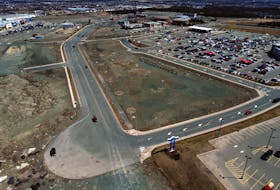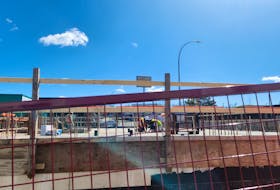LOUISBOURG - Decked out in a green camouflage uniform and goggles, Aaron Clark looks just like any other Canadian soldier clambering out of a hulking light armoured vehicle.
But when he speaks, his accent is pure British, revealing a young man from Southampton who enjoys his fish and chips and at least tries to support Chelsea Football Club.
Clark wanted to be a soldier ever since his childhood in England, but it was in Canada that he followed in his ancestors footsteps at the Fortress of Louisbourg, clearing the old forest trail used by the Redcoats in their 1758 battle with France.
About six years ago, Clark and his family moved to Halifax where he finished high school and joined the military. And those decision has led him to Louisbourg on Cape Breton Island.
“Today we’re going to continue with a trail project that we’re working on. We’re about a few Ks (kilometres) in now and we’ll hike back and continue cutting,” said Clark.
His 4 Engineer Support Regiment is leading Exercise Nihilo Sapper 2017 this month, a test of the combat engineers’ trail-clearing, construction, organizational and fighting skills.
Clark and his fellow soldiers partaking in the exercise are working as if they are in territory filled with insurgents, some of whom blocked a bridge Tuesday morning as part of the exercise scenario.
“They blocked our path but it’s been contained for now, so we should be good to move soon,” said Clark, standing next to an army LAV.
His boss, Lieutenant Nicole Wight, led the unit in clearing the ‘siege trail’ through the forests around Louisbourg where British soldiers attacked the French settlement more than 300 years ago.
During the historical battle, the British troops overpowered their French enemies by launching a naval bombardment and beach assault, as well as sending soldiers through the forests to outmaneuver their foes and capture the town.
Today, the old battle trail is overgrown in many areas by trees and shrubs, but the regiment is clearing vegetation to help archaeologists from Parks Canada access historical ruins left behind by the British.
“We’re using a variety of chainsaws, bush saws, axes and machetes just to clear some of the downed trees, clear some of the trees that are going to fall and to clear some of the younger growth so that the trail can be maintained in the future,” said Wight.
Louisbourg was a fortified town founded by early French settlers in 1713 close to modern-day Sydney. Over the next 20 years, the French built fortifications around the community, which was a local fishing hub.
The first British attack came in 1745, when troops sailing up from New England captured the town, later returning it to France as part of a peace deal.
But the British soon came back.
“A very large siege took place in 1758, when a large British force of 30,000 troops sailed over to take Louisbourg, which was defended by 8,000 French troops and militia as well,” said archaeologist Rebecca Dunham.
Using both their naval and land forces, the British again captured the town after a two-month siege.
Dunham said that Louisbourg’s capture opened the way to Quebec from the Atlantic seafront, allowing the British to invade in the following year.
British-Canadian soldier walks in ancestors’ footsteps at Louisbourg
Army engineers help unveil the past as part of training exercises

STORY CONTINUES BELOW THESE SALTWIRE VIDEOS
Two accused teenagers to remain in custody for at least two more weeks | SaltWire #newsupdate #news








